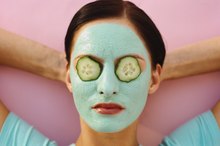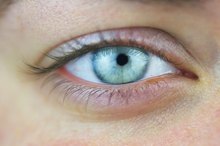Does Facial Exercise Stretch the Skin?
You use a bicep curl to tighten the muscles in your arm -- so many contend that exercises to tighten the facial muscles can help tighten the skin. While you do have muscles in the face, exercise to tighten them can have unintended consequences: breaking down the elastic fibers and stretching your skin before its time. Some methods used to stimulate circulation can be beneficial by helping to bring blood and nutrients to the skin to replenish skin cells and send toxins into the lymphatic system for drainage, resulting in temporarily tighter skin. However, facial exercises may prematurely stretch the skin.
Significance
Facial exercises involve making movements like pouting the lips, smiling or moving the eyebrows up and down to exercise the skin. Some products on the market to exercise the skin include facial masks that stimulate the skin or that you wear while performing facial exercises. The idea behind facial exercises is to strengthen the muscles underneath the skin, to make the skin appear more lifted and less sagging. However, facial exercises do not build muscle in the same manner as your weightlifting routine. In fact, facial treatments such as botulinum toxin injections work to weaken facial muscles because facial contractions cause lines.
- Facial exercises involve making movements like pouting the lips, smiling or moving the eyebrows up and down to exercise the skin.
- Some products on the market to exercise the skin include facial masks that stimulate the skin or that you wear while performing facial exercises.
Wrinkle Causes
What Causes Wrinkles Between the Eyebrows?
Learn More
Your face is the part of your skin exposed the most to the environment, including wind, sun and pollutants. Over time, the elastic and collagen fibers that give your skin its texture begin to break down, which causes wrinkling and sagging. Wrinkling typically occurs at the areas where you experience the most facial movement, such as on your smile lines or forehead when you raise your eyebrows. Facial muscles have very little to do with skin wrinkling. Instead, it is the fibers in skin that contribute to wrinkles and lines.
- Your face is the part of your skin exposed the most to the environment, including wind, sun and pollutants.
- Instead, it is the fibers in skin that contribute to wrinkles and lines.
Expert Insight
Although other areas of the body, such as your arms or legs, may tighten when you engage in resistance-training exercise, facial skin is thinner and more susceptible to stretching. "If you cause unnecessary stretching of the elastic skin, it will cause failure of the elastic fibers and it will sag and stretch out sooner," says Dr. Neal Schultz, a dermatologist speaking on DermTV. "Facial exercise is a total no-no for helping your facial skin and texture.”
Recommendation
How to Keep the Skin on My Face From Sagging After Weight Loss
Learn More
Instead of facial movements to tighten the skin, you can practice massage exercises to stimulate circulation, which can be beneficial to your skin. The Consumer Guide to Plastic Surgery recommends taking the pads of your fingers to gently massage areas where you may experience facial tension such as the forehead, cheeks and jaw 2. This can manually stimulate good circulation in your face, which can facilitate lymphatic drainage that contains bacteria, without stretching the face.
Related Articles
References
- Oprah.com: Oprah Beauty Lab
- Consumer Guide to Plastic Surgery: Facial Exercise
- Kochhar A, Larian B, Azizzadeh B. Facial Nerve and Parotid Gland Anatomy. Otolaryngol Clin North Am. 2016;49(2):273-284. doi:10.1016/j.otc.2015.10.002
- De Seta D, Mancini P, Minni A, et al. Bell's Palsy: Symptoms Preceding and Accompanying the Facial Paresis. ScientificWorldJournal. 2014;2014:801971. doi:10.1155/2014/801971
- Centers for Disease Control and Prevention. Stroke Signs and Symptoms. Updated January 31, 2020.
- Bhupal HK. Ramsay Hunt syndrome presenting in primary care. Practitioner. 2010;254(1727):33-35, 3.
- National Institute of Neurological Disorders and Stroke. Guillain-Barré Syndrome Fact Sheet. Updated August 13, 2019.
- National Institute of Neurological Disorders and Stroke. Cerebral Aneurysms Fact Sheet. Updated August 13, 2019.
- Jowett N. A General Approach to Facial Palsy. Otolaryngol Clin North Am. 2018;51(6):1019-1031. doi:10.1016/j.otc.2018.07.002
- Jin H, Wang S, Hou L, et al. Clinical treatment of traumatic brain injury complicated by cranial nerve injury. Injury. 2010;41(9):918-923. doi:10.1016/j.injury.2010.03.007
- Chen MC, Tseng TM, Hung SH, Chen PY. Facial nerve schwannoma: A case report and review of the literature. Oncol Lett. 2014;8(6):2787-2789. doi:10.3892/ol.2014.2550
- Karp E, Waselchuk E, Landis C, Fahnhorst J, Lindgren B, Lyford-Pike S. Facial Rehabilitation as Noninvasive Treatment for Chronic Facial Nerve Paralysis. Otol Neurotol. 2019;40(2):241-245. doi:10.1097/MAO.0000000000002107
- Albathi M, Oyer S, Ishii LE, Byrne P, Ishii M, Boahene KO. Early Nerve Grafting for Facial Paralysis After Cerebellopontine Angle Tumor Resection With Preserved Facial Nerve Continuity. JAMA Facial Plast Surg. 2016;18(1):54-60. doi:10.1001/jamafacial.2015.1558
Writer Bio
Rachel Nall began writing in 2003. She is a former managing editor for custom health publications, including physician journals. She has written for The Associated Press and "Jezebel," "Charleston," "Chatter" and "Reach" magazines. Nall is currently pursuing her Bachelor of Science in Nursing at the University of Tennessee.








